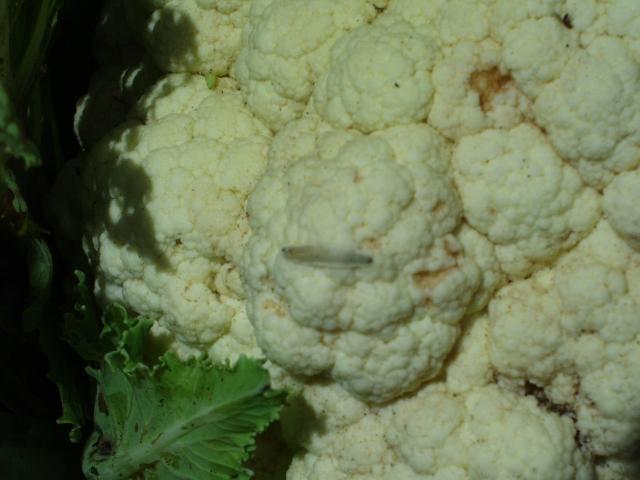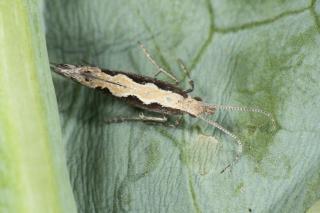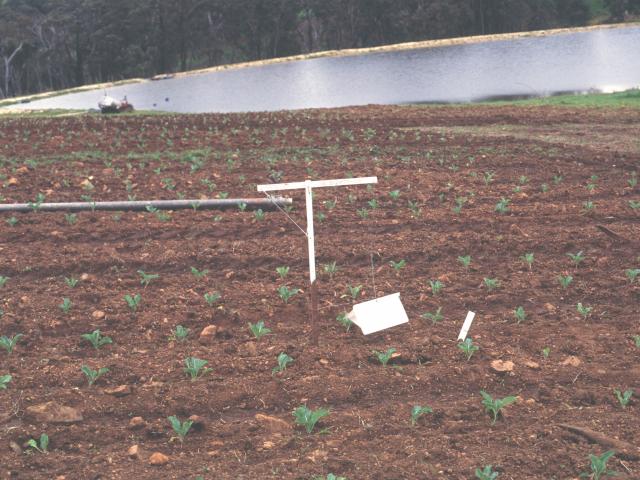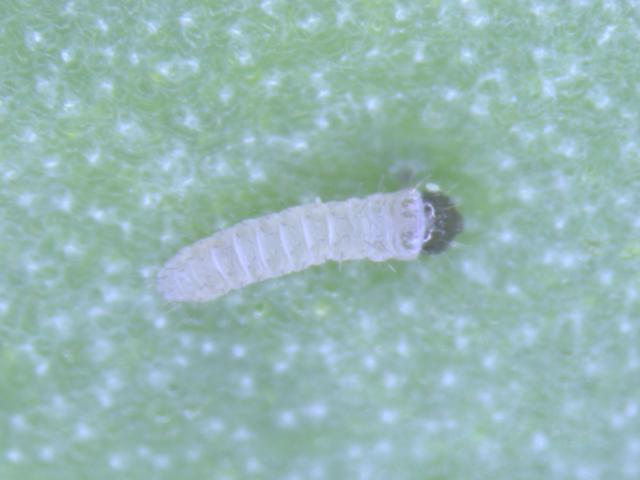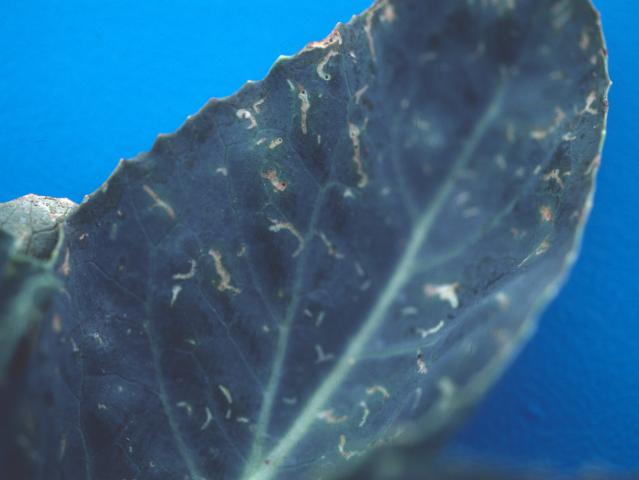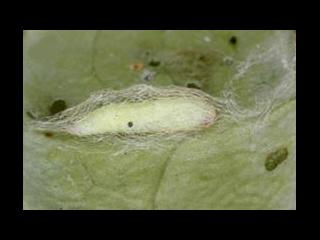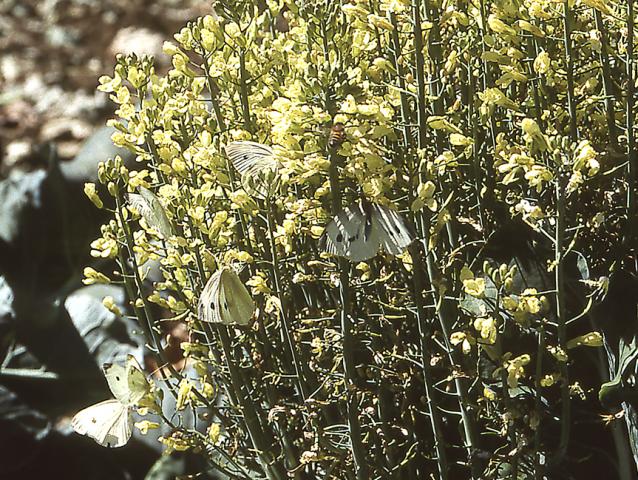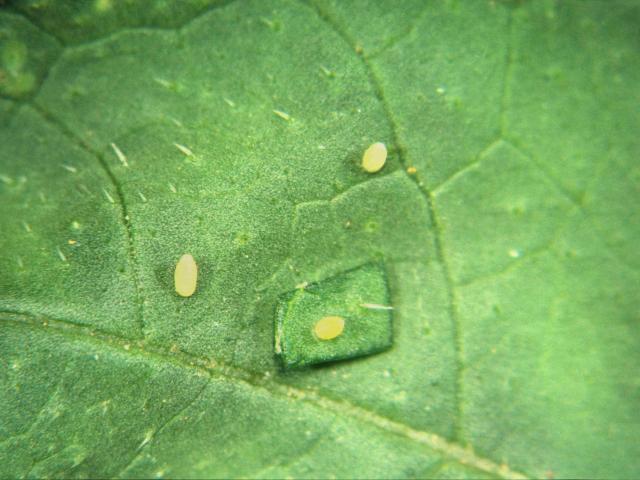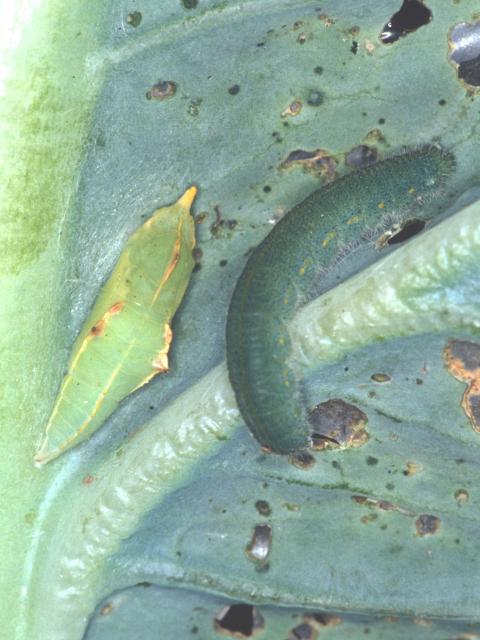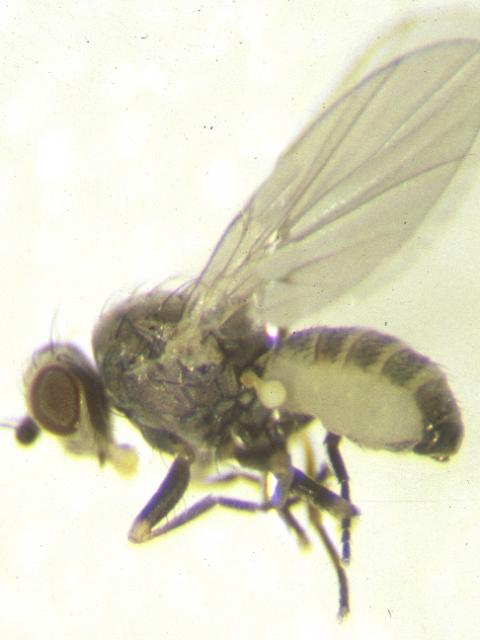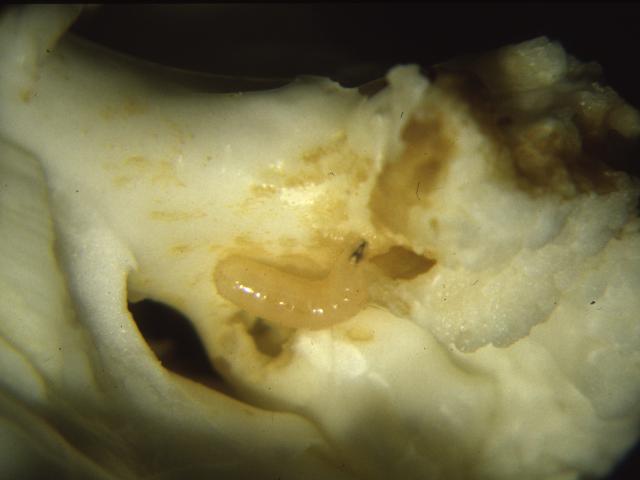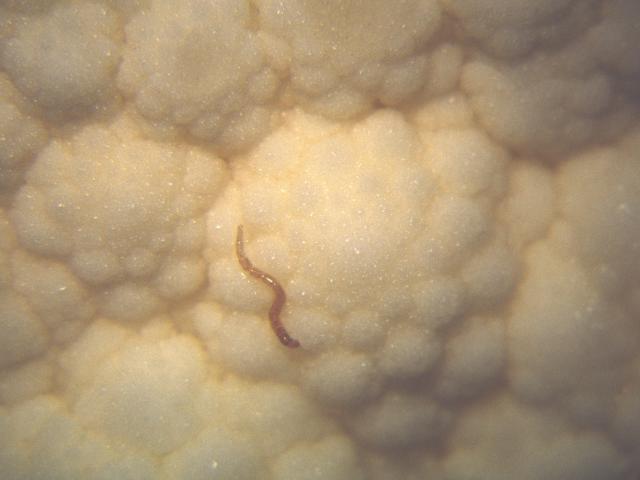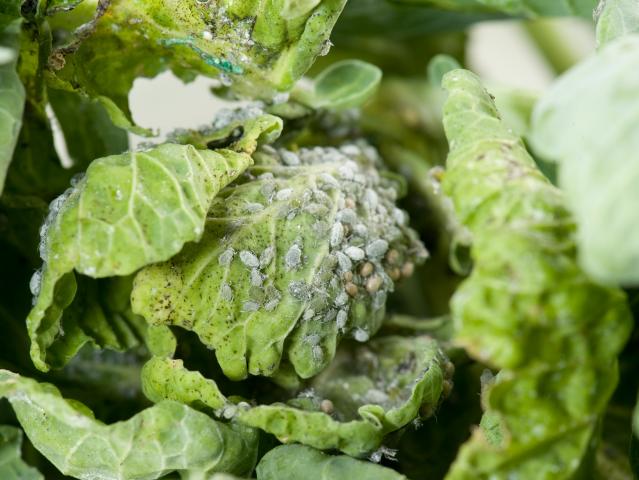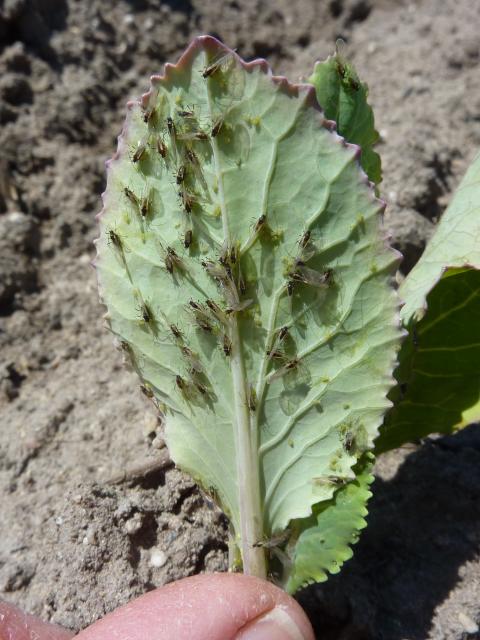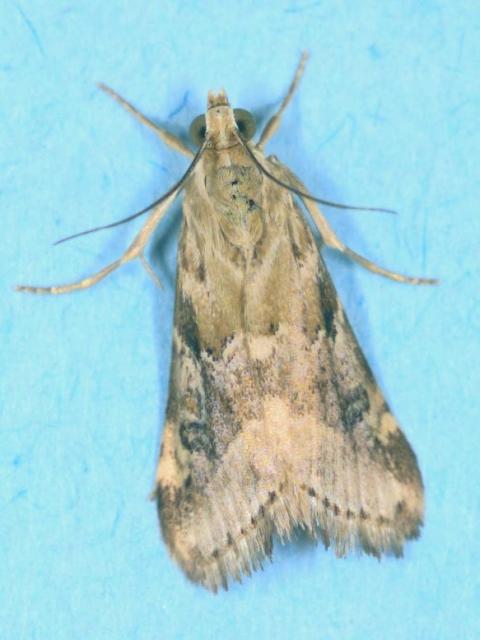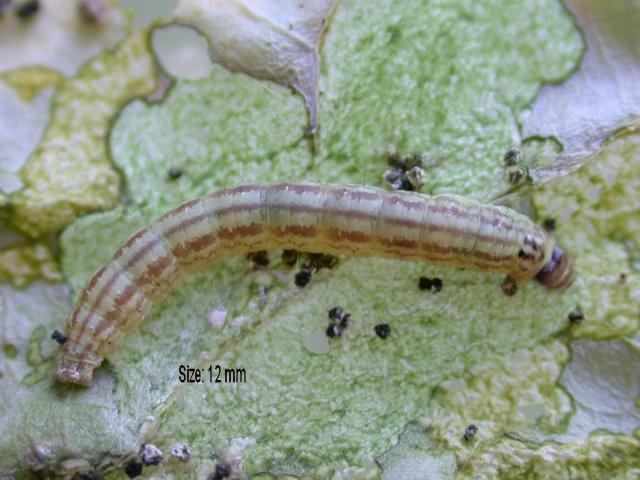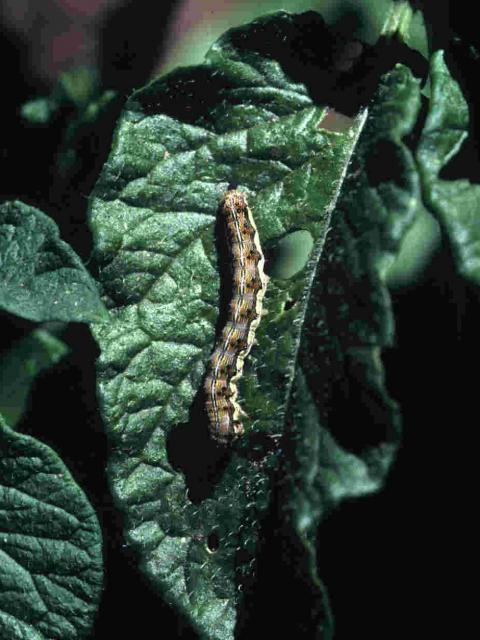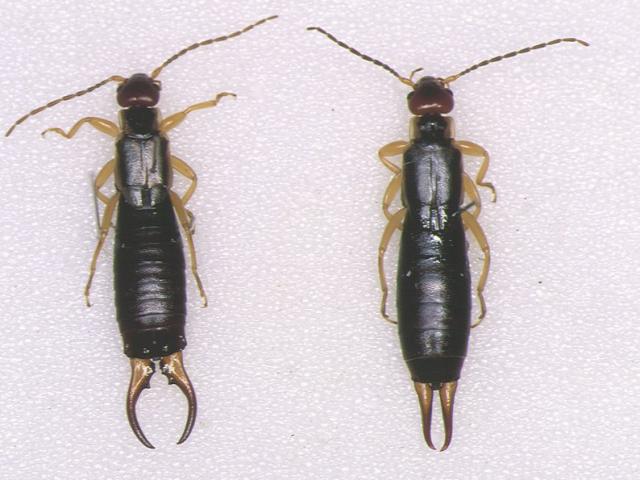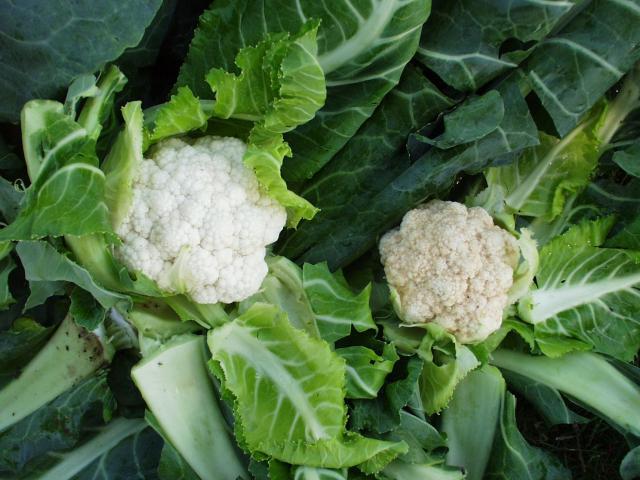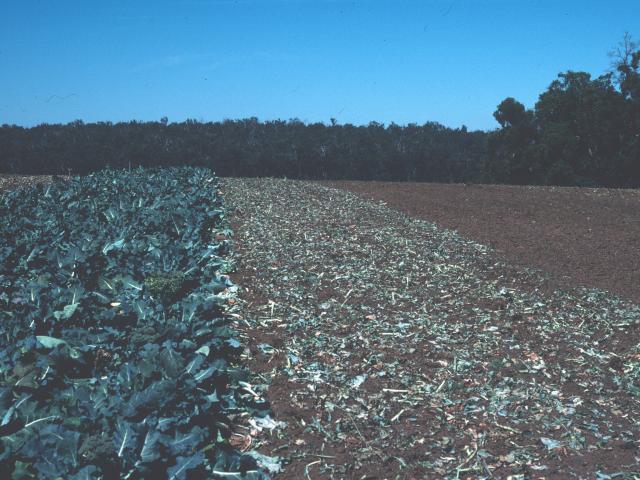Insects affecting crop growth and quality
A range of insects feed on leaves of brassica plants of any age, which may retard plant growth.
The extent of leaf damage by larvae of the pest diamondback moth to cauliflowers can be seen in this photo where the section of the crop in the front left was not treated with insecticide.
Some leaf feeding pests feed directly on the harvested part of the crop such as this damage to a cauliflower curd by diamondback moth larvae, resulting in direct crop loss through rejection.
Diamondback moth
Diamondback moth adults are small, grey/brown moths about 10mm long. When the wings are folded over the back of resting moths, they form a diamond pattern.
Pheromone traps to monitor diamondback moth adults help define the time of arrival of spring moths. Later in the season, the number of moths caught may indicate the level of pest pressure and assist with monitoring crops for larvae and deciding whether sprays are required.
One trap per crop near the crop edge and at crop height is sufficient to gauge moth numbers. Adjust trap height to be the same as the crop as it grows. Check traps weekly. Traps should be considered secondary to regular crop scouting for larvae.
Diamondback moth eggs are laid on any part of the above-ground brassica plant, but usually on the upper side of cauliflower leaves. They are relatively flat, about 0.5mm long and can be laid singly, but usually in groups of two to six.
When first laid eggs are white to yellow but turn dark yellow/grey as the grub inside develops, showing the head capsule of the grub. After eggs hatch the transparent shell remains. Use a x10 hand lens to help identify eggs.
After hatching, diamondback moth first instar grubs commence feeding by leaf mining. This gives a ‘scribble pattern’ of lines to the leaf. Very young grubs can be distinguished from cabbage white butterfly grubs (see photo below) by the presence of a dark band just behind the head. The dark band is a series of hairs not present on young cabbage white butterfly grubs. Use crop monitoring charts to assess the need to spray to protect crops from attack.
Diamondback moth larvae grow to 15 to 20mm long. They are grey-green and soft-bodied. They exhibit rapid forward or backward movement or may hang from a leaf by a silk thread when disturbed.
They feed on leaves of brassica crops which vcan be important if infestations are heavy during crop establishment. But they are also important because they can damage the harvested part of the crop - leaves, if these remain with the curd, and the curd itself. This considerably reduces quality and increases rejection of product.
When mature, diamondback larvae pupate inside a woven silk cocoon on any above-ground part of brassica plants. Pupae are around 10 to 12mm long.
Cabbage white butterfly
Adult cabbage white butterflies are large day-flying butterflies about 25mm long, with a wingspan of about 50mm. They are cream-coloured. Females have two black spots on the forewing and males one. Both have black tips on the forwing and one black spot on the hind wing.
Eggs look like sharp-pointed rockets about 1mm high. They are laid on leaves and are white when first laid but later darken to yellow.
Early stage larvae of cabbage white butterfly larvae do not have dark hairs behind their heads as is the case for diamondback moth early stage larvae. Cabbage white butterfly larvae are green with yellow stripes alongg their back and sides and covered with hairs. They grow to 25 to 30mm long.
Larvae of cabbage white butterfly are mainly leaf feeders, but their faecal deposits may foul the harvested parts of brassica vegetables.
Pupae form at the completion of grub development on the above-ground part of a brassica plant. The grub weaves a silken thread attached to the leaf to support and anchor the pupa while it develops into a butterfly.
Onion maggot (South)
Onion maggot adults are grey flies, about 2 to 3mm long. They are difficult to detect in brassica crops because other very similar flies such as ferment flies are often present. The maggots of these other flies may feed on decaying organic matter in or near the crop. Ferment fruit fly or drosophila fly, which is honey-brown with red eyes, is easily distinguished from onion maggot flies.
The larval stage of onion maggot feeds on cauliflower curds producing unsightly brown grooves, rendering curds unfit for sale. The feeding of the maggot provides an entry point for disease and soft rot may develop on the curd.
Onion maggot may pupate on cauliflower curds.
Curd-feeding fly (South)
Another species of curd-feeding fly has small brown to red worm-like larvae or maggots which cause similar damage to onion maggot. The adults of this fly are even smaller than onion maggot adults but are also grey and not readily detected. This species is very uncommon and has not been identified.
Cabbage aphid and green peach aphid
Cabbage aphid and green peach aphid are pests of brassica crops because numbers build up and retard plant growth during establishment of crops, and their presence reduces the quality of the harvested crop.
In the cool moist conditions of spring, aphids are likely to be held in check by natural enemies.
In autumn, they are more likely to build up to damaging numbers before natural enemies control them. Turnip aphid, which appears similar to cabbage aphid, can also infest vegetable brassica crops.
Cabbage centre grub (Metro)
Cabbage centre grub moths are about 12mm long and rapid fliers. They are light brown with dark brown markings. Cabbage centre grub is a minor pest of WA vegetable brassicas and has been restricted to the Perth and northern regions of the state. It is more often seen during hot weather.
The cabbage centre grub larva is cream-coloured with red to brown longitudinal stripes. Young larvae have a black head capsule and a small black mark behind the head. Older grubs have a red to brown head capsule and reach up to 12mm long.
They sometimes tie the leaves together with webbing or create large blisters inside the leaf. They may also burrow into the growing point or the main vein of a leaf. Larvae pupate on the plant within their feeding tunnel.
Heliothis moth
Heliothis moths are stout, buff-coloured, strong flying, moths, about 20mm long.
Eggs of heliothis are dome-shaped and white when first laid, and turn pink then almost black before hatching. If parasitised by a small wasp, they turn completely black.
Heliothis larvae vary in colour from green, through yellow to brown and black. They have a leathery skin and a prominent light stripe along each side. These larvae damage brassica plants by feeding on the growing tip, heads and leaves. They are not a common pest of vegetable brassica crops.
Looper grubs
Looper larvae are bright green and grow to about 35mm long. They have legs on the thorax and abdomen and move in a characteristic looping action. They feed on leaves but their faeces may foul the harvested parts of brassica crops. They are not a common pest of vegetable brassica cops.
European earwig (South)
European earwig has a black body and distinctive yellow legs, pincers and shoulders. Adults are 12 to 20mm long. Males (left) have curved pincers while females have long straight pincers. They feed on leaves and cauliflower curds. Their faeces may foul harvested portions of crops. They are not a common pest and can be distinguished from the native earwigs, which are reddish brown. European earwigs are often present in large numbers but preatory earwigs are usuall solitary.
Staphylinid beetle (South)
Staphylinid beetle is a relatively new pest of cauliflower in the South-West. Adults are small, 1 to 2mm long, black elongate beetles which can fly. Little is known of their biology but it is likely the larval stage feeds on decaying organic matter in moist situations near brassica crops. Adults would fly into nearby crops and may reach heavy infestations over a short period of time.
Adults browse on the curd, rendering it brown and unmarketable. By the time damage is noticed, control is impossible. Should this insect become a consistent pest, monitoring methods will need to be developed to detect the pest early enough to prevent damage.
Destroying crop residues as soon as possible after harvest is completed can help reduce the risk of pests building up in these unsprayed areas which can infest nearby crops.

